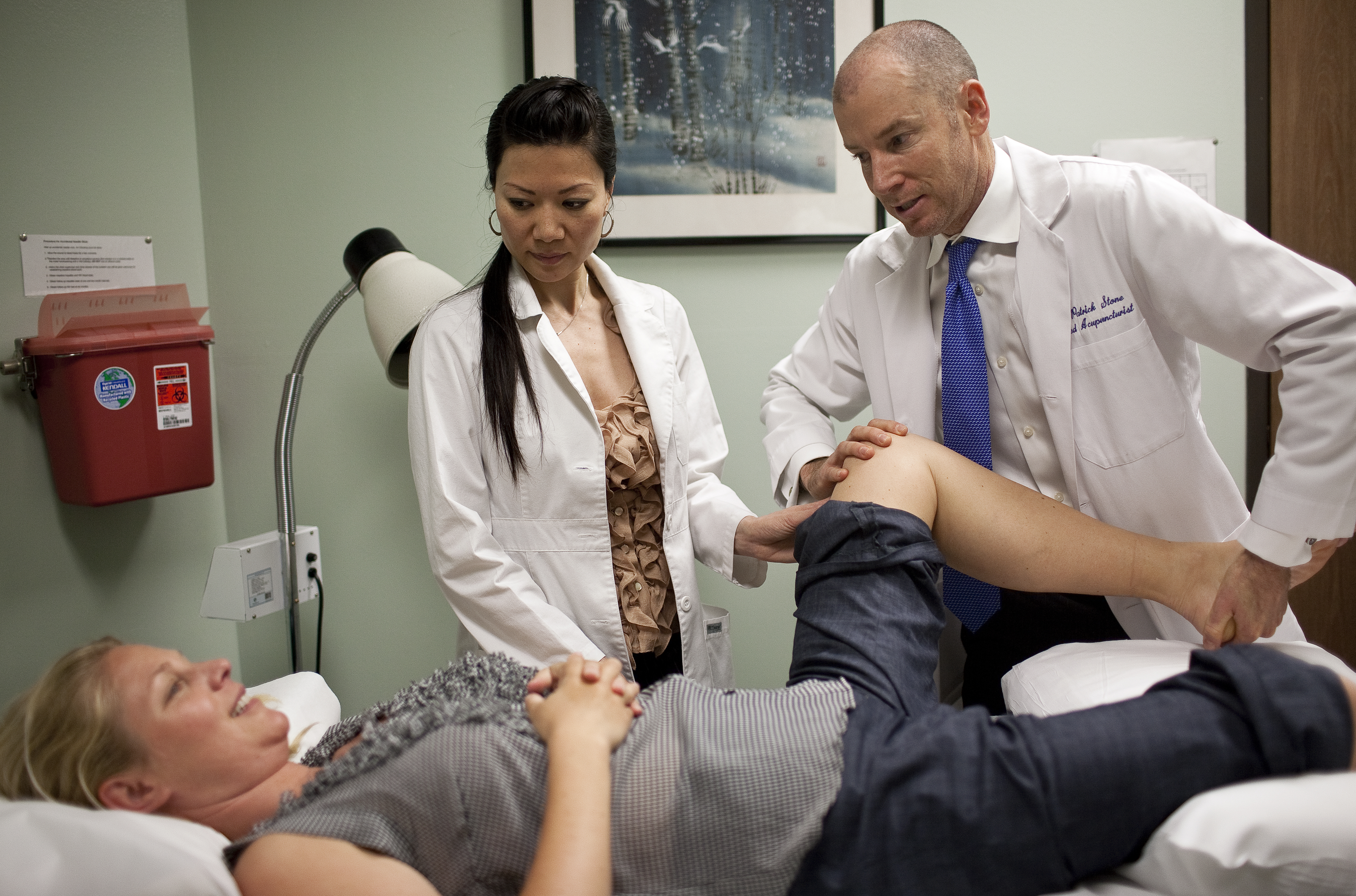UCLA pre-med students interested in alternative medicine shadow acupuncturist for internship

Mia Nguyen, a clinical intern at Emperor’s College Acupuncture Clinic in Santa Monica, and licensed acupuncturist Steven Stone work on a patient’s swollen knee by feeling for certain pressure points. UCLA pre-med students observed the treatment for an internship with the clinic.
By Alexander Baklajian
May 8, 2012 1:13 a.m.

UCLA students observe as a needle is placed on Kate Winslow, a fourth-year student at Emperor’s College Acupuncture Clinic, during an acupuncture lesson.

Daniel Martinez (middle) and Molly Ruiz (right) are both third-year pre-med students and members of Nutrition, Complementary and Alternative Medicine at UCLA. They shadow Steven Stone (left), a licensed acupuncturist, at Emperor’s College Acupuncture Clinic.
An observant and inquisitive group huddled around the examination table in a Santa Monica clinic as an acupuncture student reassured her patient.
“Take a deep breath. Don’t be nervous,” the student said.
In one swift motion, she nudged the tail end of a plastic applicator device and slid the tip of a small needle under the skin of her patient, right between the eyes.
Among the observers were UCLA pre-med students Daniel Martinez and Molly Ruiz, who are members of the Nutrition, Complementary and Alternative Medicine student group, an organization that promotes healthy living through education.
Students from the organization have been participating in an internship at the Emperor’s College Acupuncture Clinic this quarter, shadowing acupuncturist Steven Stone as he examines and treats patients.
The shadowing program began last year when the student group approached the clinic to learn more about the practice of acupuncture, said Lisa Rocchetti, director of admissions and marketing at Emperor’s College of Traditional Oriental Medicine. UCLA does not currently offer an acupuncture degree program for non-medical students.
Courses in acupuncture are part of the curriculum for students at the UCLA David Geffen School of Medicine, said Lawrence Taw, an assistant clinical professor at the UCLA Center for East-West Medicine, which offers acupuncture as part of its clinical services.
Acupuncture, an Eastern medicine technique that originated in China, involves inserting small needles at various points on the skin to treat pain or disease. There is ongoing research on the benefits and effectiveness of acupuncture for a range of conditions, according to the National Institutes of Health.
Taw said acupuncture has been shown to mitigate pain and reduce nausea. In a 2007 NIH survey, an estimated 3.1 million Americans had used acupuncture in the previous year.
The practice is especially popular in California because state laws allow acupuncturists to act as primary care providers, performing routine checkups for their patients and ordering any necessary blood and imaging tests, Rocchetti said.
Every weekend, the students shadow acupuncturists as they consult with patients to determine the best course of treatment and “needle” patients.
While the patient undergoes treatment, students also observe how acupuncturists assemble custom-made herbal formulas for the patients to use in addition to their therapy. The facility has a large on-site pharmacy that contains exotic herbs that come mostly from China, Rocchetti said.
During Saturday’s visit, the patient came in chiefly complaining of knee inflammation and fatigue. She was lying on an exam bed with around 10 needles inserted at various points throughout her body, from the back of her head down to both legs.
The acupuncturist produced an electrical stimulation device from under the table, attaching the leads to needles on either side of the patient’s affected knee and sending an electric current through her body from one needle to the other.
Martinez, a third-year psychology student, said he often sees patients who are concerned about undergoing the procedure due to preconceived notions about its pain and effectiveness.
“People are afraid it will hurt, but you really don’t feel it at all,” said Ruiz, a third-year anthropology student.
Martinez was most interested in what acupuncturists call the “meridian system” ““ a map that tells them where to “needle” patients based on their symptoms, she said.
“You can have pain in the neck that’s helped by a needle in the foot,” Martinez said.
For example, treating the “three-mile” point in the right side of the lower right leg can enable someone to travel another three miles when they are fully exhausted and can’t take another step, Stone said.
There are points that have been clinically shown to improve blood flow throughout the body and reduce inflammation, he said.
Stone, an acupuncturist for more than a decade, said he was critical of acupuncture at first, but turned to the field after he had knee surgery and was told he would not be able to take up running again.
Since undergoing treatment, he has competed in triathlons and said he is now so confident in the practice that he needles himself.
Martinez and Ruiz were also initially skeptical about acupuncture to treat chronic pain. But they now say they hope their knowledge of acupuncture and other Eastern medicine techniques will make them better physicians one day. Both added that the experience has changed the way they view medicine.


